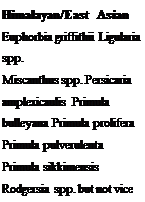Steppe is the term used to describe a diverse range of dry grasslands that occur from Central Europe through Eastern Europe, to Siberia and China (Figure 6.3). A number of types are recognised, for example, forest-steppe, tuft grass steppe, sagebrush steppe, mountain steppe, meadow steppe and semidesert steppe (Archibold 1995). In Europe, the distinction between dry meadows and steppe is rather indistinct, with steppe representing
 |
6.3
Steppe grassland in Eastern Austria, dominated by Stipa spp.
Table 6.3. Commonly cultivated forbs and grasses characteristic of wet meadows in various parts of the world (derived from Polunin and Stainton 1984; Ellenberg 1988; Jelitto and Schacht 1990; Phillips and Rix 1991a, 1991b; Chatto 1992; Rodwell et al. 1992; Hansen and Stahl 1993; Fitter et al. 1995; plus the observations of the author)

 Central Europe*
Central Europe*
Cirsium rivulare Delphinium elatum Euphorbia palustris Hemerocallis flava Iris sibirica
Molinia caerulea sub sp. arundinacea Polemonium caeruleum Thalictrum aquilegifolium Veronica longifolia
under Britain also occur in Central Europe,
communities exposed to particularly severe soilmoisture stress. As a result, in Europe some species are common to both dry meadow and steppe communities (Ellenberg 1988). Steppe becomes a more distinctive plant community as continental effects increase as one moves east. Steppe is typically associated with sites that experience extremely cold winters, moist springs and hot dry summers. The dominant plants are grasses with Stipa, the feather grasses, a characteristic genus. Many steppe grasses form distinctive discrete tussocks, in contrast to the more amorphous form of many meadow grasses.
The evolution of steppe grasslands is often ascribed to drying out of the climate during the Pleistocene, favouring the development of grassy vegetation. This straightforward explanation is increasingly challenged; most of the woody species occurring within the current steppe region are equally or more drought-tolerant than the grasses and forbs. In most arid parts of the world, it is woody, not herbaceous plants, that dominate. It seems possible that the combination of wild and domesticated herbivores and deliberate, regular burning by human hunter-gatherers have played a major part in the development of this vegetation type.
Because of the cold winters and hot dry summers, most steppe species grow and flower between mid-spring and early summer, then enter a dormant state and ‘brown off’. Bulbous plants, such as Tulipa, are important spring components in Asia. In Central Europe, steppe is associated with very dry infertile, low-productivity sites. However, in Eastern Europe and Asia it is often associated with more productive ecosystems. In
southern Russia, for example, steppe supports large growing species, such as Phlomis tuberosa (Table 6.4).
When steppe occurs on low-productivity sites, a very open, low-growing vegetation with a large percentage of bare ground (covered by mosses in autumn to spring) results. In a design sense this is the dominant visual stereotype for steppe vegetation. In the less continental climates of western Europe, ‘designed’ steppe communities that mimic this community are often difficult to manage, even on dry infertile soils. Due to mild winters and reliably year round rain, ongoing weed colonisation of the gaps between plants presents a challenge to managers. Closer spacing reduces weed invasion but many small growing steppe species are intolerant of shading and the planting design or sowing mix used must avoid too high a percentage of tall or widespreading species. An ideal site to undertake steppe-like plantings or sowings of this type are green roof systems involving a minimum of 90 mm of substrate of leca and composted organic material, as discussed by Dunnett (2002). Initially, these substrates are normally free of weed seeds and the severe summer moisture stress experienced assists in favouring the development of steppe species over vigorous weed species.
|
Table 6.4. Commonly cultivated forbs and grasses characteristic of steppe in various parts of the world (derived from BdB 1987; Ellenberg 1988; Jelitto and Schacht 1990; Phillips and Rix 1991a, 1991b; Hansen and Stahl 1993; Archibold 1995; plus the observations of the author)
|
|
|
6.4
Tall grass prairie dominated by Echinacea pallida, Morton Arboretum, Chicago (early July).
Note the C4 grasses that later in the year will dominate this prairie




